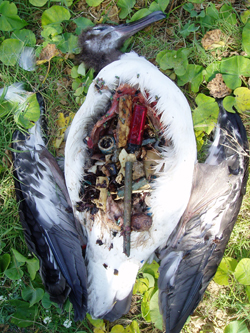|
|
For the past decade, an annual volunteer drive involving thousands of
divers from all over the world has taken place in an effort to lessen
the plastic content of the ocean. This year’s International Cleanup
Day is scheduled for September 19th and registration is open to
certified divers and other volunteers who would like to do their part
to save a choking ocean.
The world’s oceans contain millions of tons of plastics, most of which
are discarded on land and wend their way down rivers and along coasts
until eventually they are carried into the middle of the sea. The most
dramatic example of this is the “great Pacific garbage patch” which is
a mass of plastic debris about twice the size of Texas in the North
Pacific.
 Laysan Albatross chick full of plastic marine debris on Green Island at Kure Atoll State Wildlife Refuge in the Northwestern Hawaiian Islands Marine National Monument. Claire Fackler, NOAA National Marine Sanctuaries |
Predicted in the 80s and discovered in the 90s, the patch is not
detectable by satellite as it lies at and immediately below the
surface of the sea. If viewed from the deck of a boat, however, it is
immediately clear by the pails, bottles, and other detritus floating
past that one is sailing through a soup of plastic. Oceanic garbage
accumulations are composed of both largely intact pieces of refuse and
those that have been broken down into a plastic sludge. Plastic is not
capable of biodegrading; it remains as a polymer even when decomposed
to a molecular level. These tiny particles are then capable of being
incorporated into the food chain. Large plastics themselves are a
hazard to many members of the marine ecosystem. Albatross, for
example, often mistake pieces of plastic debris for squid and other
prey species. Sadly, the albatross digestive system cannot break down
plastic and accumulation can lead to eventual starvation.
AWARE, a nonprofit group whose mission is the preservation of marine
ecosystems, along with the Ocean Conservancy and the Professional
Association of Dive Instructors joint-organize an event called
International Clean-Up Day to encourage the large scale removal of
marine debris. Last year, 10,600 volunteer divers removed almost 100
tons of garbage from various locations around the world. In addition
to divers, the September 16th event needs volunteers to collect and
tally data. For more information about the project and how to help,
please go to www.projectaware.org or
http://www.padi.com/scuba/about-padi/padi-partners/project-aware/default.aspx.
Related articles
Hardly indestructible, plastics begin decomposing in ocean within a year, spreading harmful chemicals
(08/20/2009) Scientists had assumed that plastics were basically indestructible. While floating plastic in the ocean was dangerous to particular species of marine life which consumed them or got snared by them, the scientists thought that the threat didn’t extend beyond this. However, a new study shows that plastic in the ocean may be quite insidious. Researchers found that so-called indestructible plastics actually decompose in the ocean, releasing potentially toxic substances throughout the seas.
Plastic Vortexes Leaching Chemicals into World’s Oceans
(08/20/2009) While scientists have acknowledged the existence of billions of pounds of plastic containers, Styrofoam, and similar waste have created massive oceanic trash vortexes (floating islands of garbage), little is known of the effects of the dissolution of these materials into the water.